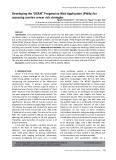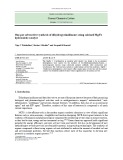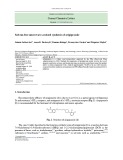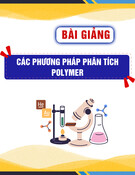
* Corresponding author.
E-mail address: jaskowskaj@chemia.pk.edu.pl (J. Jaśkowska)
2018 Growing Science Ltd.
doi: 10.5267/j.ccl.2018.08.002
Current Chemistry Letters 7 (2018) 81–86
Contents lists available at GrowingScience
Current Chemistry Letters
homepage: www.GrowingScience.com
Solvent-free microwave-assisted synthesis of aripiprazole
Jolanta Jaśkowskaa*, Anna K. Drabczyka, Damian Kułagaa, Przemysław Zarębaa and Zbigniew Majkab
aFaculty of Chemical Engineering and Technology, Institute of Organic Chemistry and Technology, Cracow University of Technology, 24 Warszawska
Street, 31-155 Cracow, Poland
bTM Labs, 14 Bieliny-Prażmowskiego Street, 31-514 Cracow, Poland
C H R O N I C L E A B S T R A C T
Article history:
Received April 28, 2018
Received in revised form
June 29, 2018
Accepted August 12, 2018
Available online
August 12, 2018
Aripiprazole is a widely used antipsychotic approved by the FDA (Food and Drug
Administration) in 2002. Methods for preparation of aripiprazole mainly involve the use of
expensive and toxic solvents, and the reaction time can be even several hours long. Our method
allows to obtain aripiprazole with a yield of approximately 70–80% over just a few minutes
using solvent-free conditions in the presence of PTC (Phase Transfer Catalysts) and microwave
radiation.
© 2018 Growing Science Ltd. All rights reserved.
Keywords:
Solvent-free synthesis
Microwave-assisted synthesis
PTC catalysts
Aripiprazole
Long Chain Arylpiperazines
(LCAPs)
1. Introduction
The antipsychotic efficacy of aripiprazole (1) is due to its activity as a partial agonist of dopamine
D2 and serotonin 5-HT1A receptors, and antagonist of a 5-HT2A serotonin receptor (Fig. 1). Aripiprazole
(1) is recommended for the treatment of schizophrenia and manic episodes.
N
H
OO
N
N
Cl
Cl
Fig. 1. Structure of aripiprazole (1)
The most widely described in the literature synthetic route of aripiprazole (1) is a reaction between
7-(4-halobutoxy)-3,4-dihydrocarbostyril (BBQ) and 1-(2,3-dichlorophenyl)piperazine (DCP) in the
presence of bases, such as triethylamine,1-3 pyridine, sodium hydroxide or hydride,1,4 potassium,1,4-13
carbonate or bicarbonate,15 sodium, 1,8,14-15 and caesium.15 in solvents such as acetonitrile,1-3,6,11,14























